Kyanite is a typically blue aluminosilicate mineral, found in aluminium-rich metamorphic pegmatites and sedimentary rock. It is the high pressure polymorph of andalusite and sillimanite, and the presence of kyanite in metamorphic rocks generally indicates metamorphism deep in the Earth's crust. Kyanite is also known as disthene or cyanite.

Schist is a medium-grained metamorphic rock showing pronounced schistosity. This means that the rock is composed of mineral grains easily seen with a low-power hand lens, oriented in such a way that the rock is easily split into thin flakes or plates. This texture reflects a high content of platy minerals, such as micas, talc, chlorite, or graphite. These are often interleaved with more granular minerals, such as feldspar or quartz.

Metamorphic rocks arise from the transformation of existing rock to new types of rock in a process called metamorphism. The original rock (protolith) is subjected to temperatures greater than 150 to 200 °C and, often, elevated pressure of 100 megapascals (1,000 bar) or more, causing profound physical or chemical changes. During this process, the rock remains mostly in the solid state, but gradually recrystallizes to a new texture or mineral composition. The protolith may be an igneous, sedimentary, or existing metamorphic rock.

Metamorphism is the transformation of existing rock to rock with a different mineral composition or texture. Metamorphism takes place at temperatures in excess of 150 °C (300 °F), and often also at elevated pressure or in the presence of chemically active fluids, but the rock remains mostly solid during the transformation. Metamorphism is distinct from weathering or diagenesis, which are changes that take place at or just beneath Earth's surface.

Amphibolite is a metamorphic rock that contains amphibole, especially hornblende and actinolite, as well as plagioclase feldspar, but with little or no quartz. It is typically dark-colored and dense, with a weakly foliated or schistose (flaky) structure. The small flakes of black and white in the rock often give it a salt-and-pepper appearance.
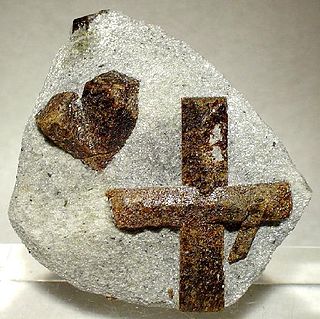
Staurolite is a reddish brown to black, mostly opaque, nesosilicate mineral with a white streak. It crystallizes in the monoclinic crystal system, has a Mohs hardness of 7 to 7.5 and the chemical formula: Fe2+2Al9O6(SiO4)4(O,OH)2. Magnesium, zinc and manganese substitute in the iron site and trivalent iron can substitute for aluminium.
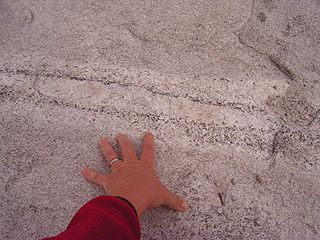
Metasomatism is the chemical alteration of a rock by hydrothermal and other fluids. It is traditionally defined as metamorphism which involves a change in the chemical composition, excluding volatile components. It is the replacement of one rock by another of different mineralogical and chemical composition. The minerals which compose the rocks are dissolved and new mineral formations are deposited in their place. Dissolution and deposition occur simultaneously and the rock remains solid.

Granulites are a class of high-grade metamorphic rocks of the granulite facies that have experienced high-temperature and moderate-pressure metamorphism. They are medium to coarse–grained and mainly composed of feldspars sometimes associated with quartz and anhydrous ferromagnesian minerals, with granoblastic texture and gneissose to massive structure. They are of particular interest to geologists because many granulites represent samples of the deep continental crust. Some granulites experienced decompression from deep in the Earth to shallower crustal levels at high temperature; others cooled while remaining at depth in the Earth.
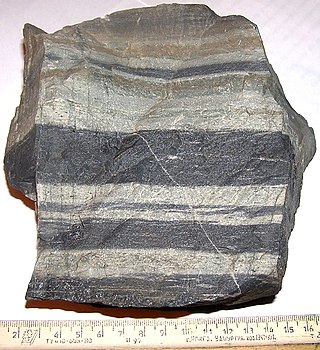
Hornfels is the group name for a set of contact metamorphic rocks that have been baked and hardened by the heat of intrusive igneous masses and have been rendered massive, hard, splintery, and in some cases exceedingly tough and durable. These properties are caused by fine grained non-aligned crystals with platy or prismatic habits, characteristic of metamorphism at high temperature but without accompanying deformation. The term is derived from the German word Hornfels, meaning "hornstone", because of its exceptional toughness and texture both reminiscent of animal horns. These rocks were referred to by miners in northern England as whetstones.

The chlorites are the group of phyllosilicate minerals common in low-grade metamorphic rocks and in altered igneous rocks. Greenschist, formed by metamorphism of basalt or other low-silica volcanic rock, typically contains significant amounts of chlorite.

Blueschist, also called glaucophane schist, is a metavolcanic rock that forms by the metamorphism of basalt and rocks with similar composition at high pressures and low temperatures, approximately corresponding to a depth of 15–30 km (9.3–18.6 mi). The blue color of the rock comes from the presence of the predominant minerals glaucophane and lawsonite.

Greenschists are metamorphic rocks that formed under the lowest temperatures and pressures usually produced by regional metamorphism, typically 300–450 °C (570–840 °F) and 2–10 kilobars (29,000–145,000 psi). Greenschists commonly have an abundance of green minerals such as chlorite, serpentine, and epidote, and platy minerals such as muscovite and platy serpentine. The platiness gives the rock schistosity. Other common minerals include quartz, orthoclase, talc, carbonate minerals and amphibole (actinolite).

Litchfieldite is a rare igneous rock. It is a coarse-grained, foliated variety of nepheline syenite, sometimes called nepheline syenite gneiss or gneissic nepeheline syenite. Litchfieldite is composed of two varieties of feldspar, with nepheline, sodalite, cancrinite and calcite. The mafic minerals, when present, are magnetite and an iron-rich variety of biotite (lepidomelane).
An isograd is a concept used in the study of metamorphic rocks. The metamorphic grade of such a rock is a rough measure of the degree of metamorphism it has undergone, as characterised by the presence of certain index minerals. An isograd is a theoretical surface comprising points all at the same metamorphic grade, and thus separates metamorphic zones whose rocks contain different index minerals.

A metamorphic facies is a set of mineral assemblages in metamorphic rocks formed under similar pressures and temperatures. The assemblage is typical of what is formed in conditions corresponding to an area on the two dimensional graph of temperature vs. pressure. Rocks which contain certain minerals can therefore be linked to certain tectonic settings, times and places in the geological history of the area. The boundaries between facies are wide because they are gradational and approximate. The area on the graph corresponding to rock formation at the lowest values of temperature and pressure is the range of formation of sedimentary rocks, as opposed to metamorphic rocks, in a process called diagenesis.
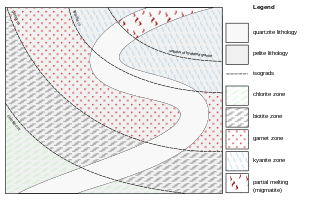
In geology, a metamorphic zone is an area where, as a result of metamorphism, the same combination of minerals occur in the bedrock. These zones occur because most metamorphic minerals are only stable in certain intervals of temperature and pressure.

A subduction zone is a region of the Earth's crust where one tectonic plate moves under another tectonic plate; oceanic crust gets recycled back into the mantle and continental crust gets created by the formation of arc magmas. Arc magmas account for more than 20% of terrestrially produced magmas and are produced by the dehydration of minerals within the subducting slab as it descends into the mantle and are accreted onto the base of the overriding continental plate. Subduction zones host a unique variety of rock types created by the high-pressure, low-temperature conditions a subducting slab encounters during its descent. The metamorphic conditions the slab passes through in this process creates and destroys water bearing (hydrous) mineral phases, releasing water into the mantle. This water lowers the melting point of mantle rock, initiating melting. Understanding the timing and conditions in which these dehydration reactions occur, is key to interpreting mantle melting, volcanic arc magmatism, and the formation of continental crust.

A petrogenetic grid is a geological phase diagram that connects the stability ranges or metastability ranges of metamorphic minerals or mineral assemblages to the conditions of metamorphism. Experimentally determined mineral or mineral-assemblage stability ranges are plotted as metamorphic reaction boundaries in a pressure–temperature cartesian coordinate system to produce a petrogenetic grid for a particular rock composition. The regions of overlap of the stability fields of minerals form equilibrium mineral assemblages used to determine the pressure–temperature conditions of metamorphism. This is particularly useful in geothermobarometry.

The Ashe Metamorphic Suite, also referred to as the Ashe Formation, was named after its type locality, Ashe County, North Carolina. The Ashe Metamorphic Suite is located in the Eastern Blue Ridge providence that extends from North Carolina up to South-Western Virginia. It is a collection of metamorphic rocks of both sedimentary and volcanic origin. Zircon dating indicates an age of 470 to 335 Ma for the unit. The protolith of the Ashe Metamorphic Suite was deposited during the Late Proterozoic and reaching its cooling age during the end of the Devonian. The Ashe Metamorphic Suite is overwhelmingly composed of amphibolites and mica schists.
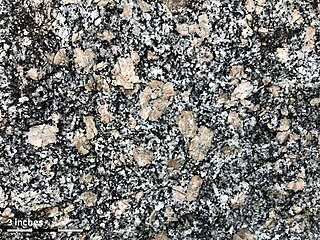
The Lilesville Granite, also referred to as the Lilesville pluton, is a ring-shaped body of granitic rock that spans about 94 square miles (240 km2) in Anson, Richmond, and Montgomery Counties in southern North Carolina.



















